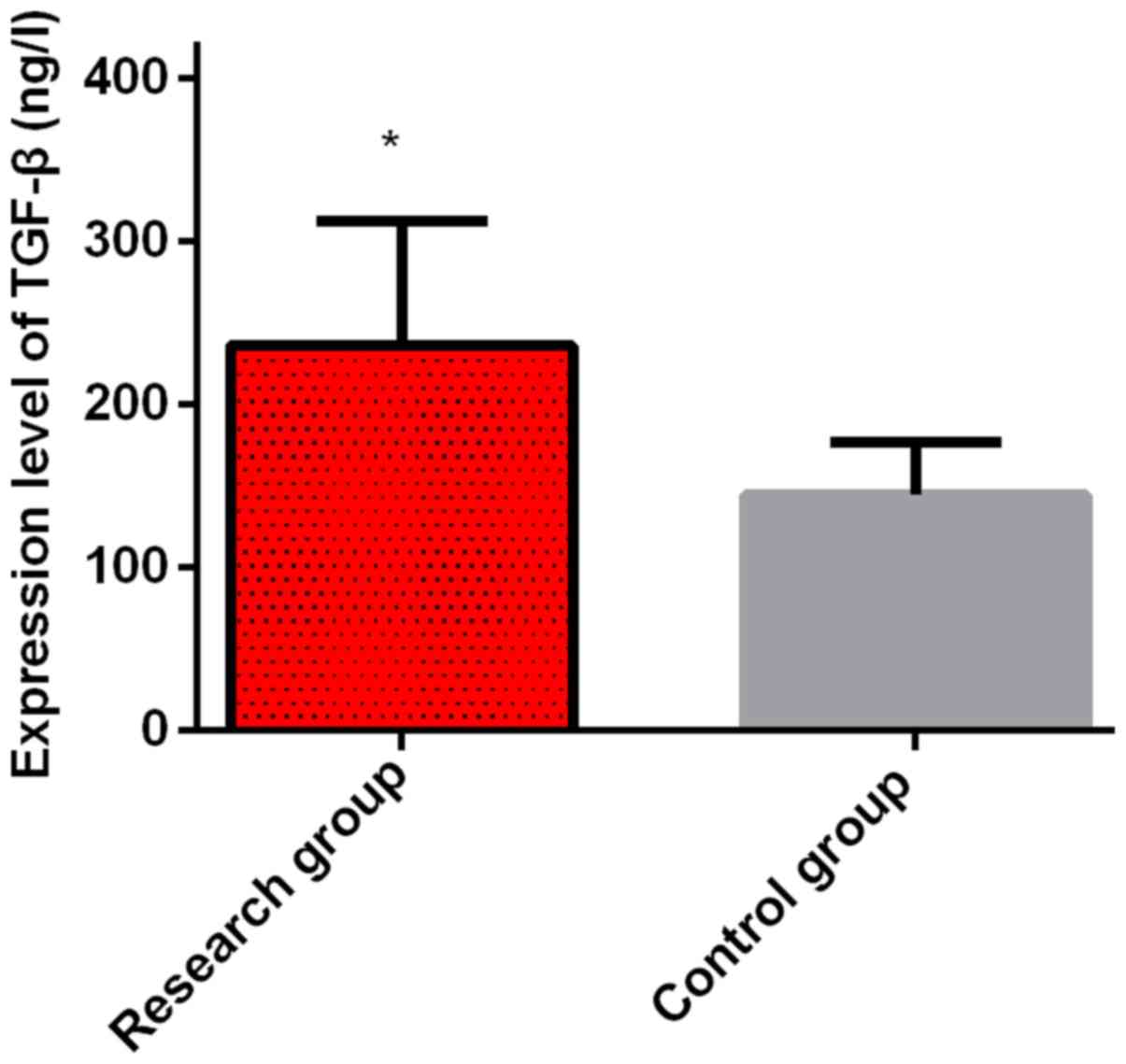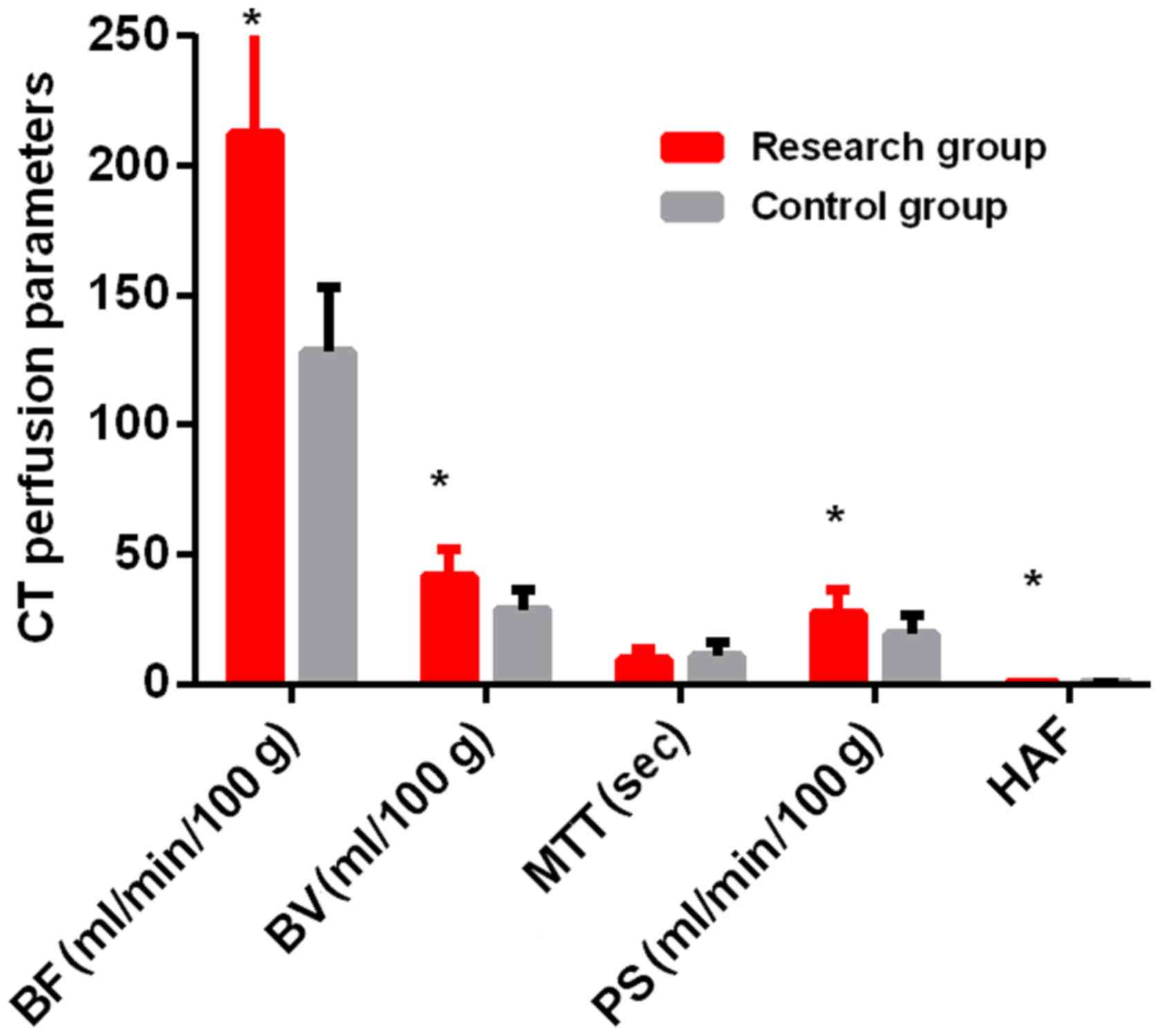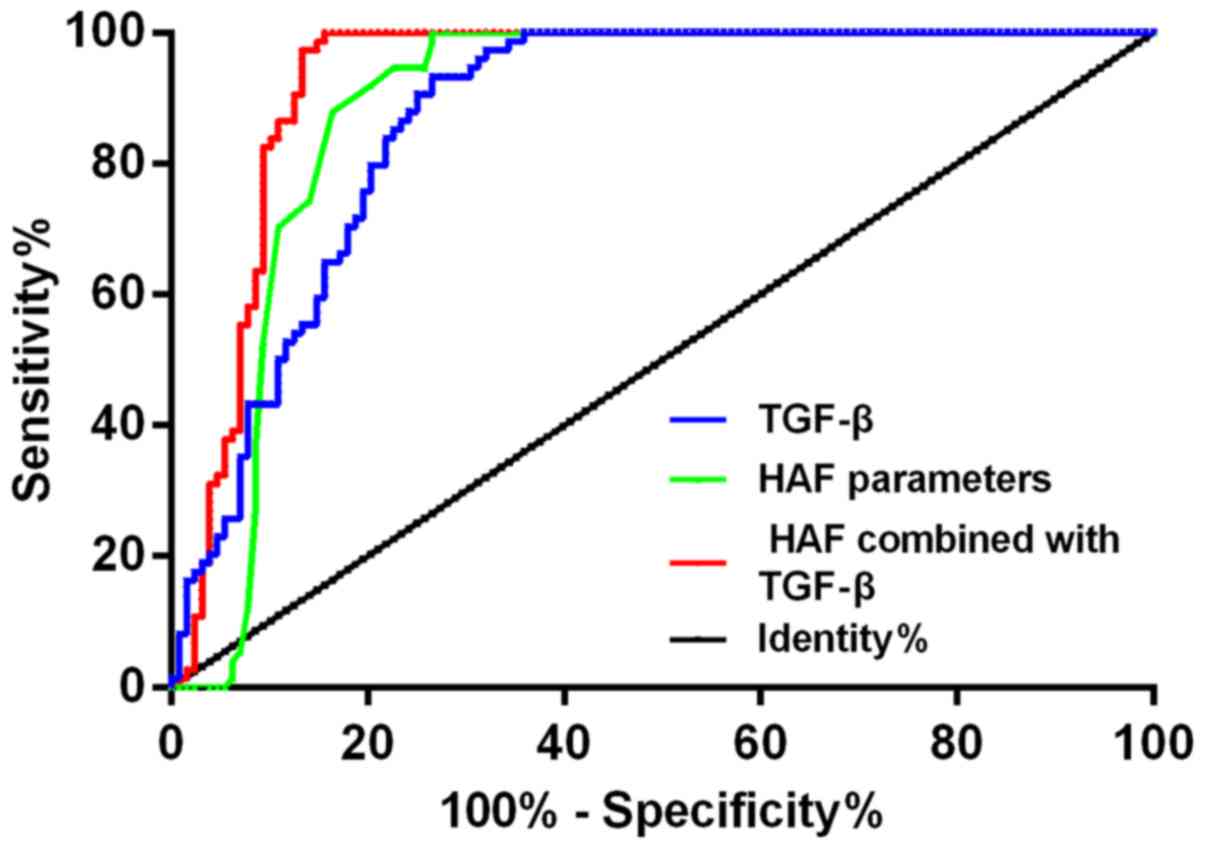|
1
|
Valery PC, Laversanne M, Clark PJ, Petrick
JL, McGlynn KA and Bray F: Projections of primary liver cancer to
2030 in 30 countries worldwide. Hepatology. 67:22017.
|
|
2
|
Tsai WC, Kung PT, Wang YH, Kuo WY and Li
YH: Influence of the time interval from diagnosis to treatment on
survival for early-stage liver cancer. PLoS One. 13:e01995322018.
View Article : Google Scholar : PubMed/NCBI
|
|
3
|
Giunchi F, Vasuri F, Baldin P, Rosini F,
Corti B and D'Errico-Grigioni A: Primary liver sarcomatous
carcinoma: Report of two cases and review of the literature. Pathol
Res Pract. 209:249–254. 2013. View Article : Google Scholar : PubMed/NCBI
|
|
4
|
Chuang SC, Lee YC, Hashibe M, Dai M, Zheng
T and Boffetta P: Interaction between cigarette smoking and
hepatitis B and C virus infection on the risk of liver cancer: A
meta-analysis. Cancer Epidemiol Biomarkers Prev. 19:1261–1268.
2010. View Article : Google Scholar : PubMed/NCBI
|
|
5
|
Romani S, Azimzadeh P, Mohebbi SR,
Kazemian S, Almasi S, Naghoosi H, Derakhshan F and Zali MR:
Investigation of transforming growth factor-β1 gene polymorphisms
among Iranian patients with chronic hepatitis C. Hepat Mon.
11:901–906. 2011. View Article : Google Scholar : PubMed/NCBI
|
|
6
|
Yao H, Chen H, Chen J, Zhu J and Zhang Y:
Long-term survival trends for liver cancer in Qidong: 1972 to 2011.
Zhonghua Gan Zang Bing Za Zhi. 22:921–925. 2014.(In Chinese).
PubMed/NCBI
|
|
7
|
Barranger E, Cortez A, Uzan S, Callard P
and Darai E: Value of intraoperative imprint cytology of sentinel
nodes in patients with cervical cancer. Gynecol Oncol. 94:175–180.
2004. View Article : Google Scholar : PubMed/NCBI
|
|
8
|
Zheng R, Zuo T, Zeng H, Zhang S and Chen
W: Mortality and survival analysis of liver cancer in China.
Zhonghua Zhong Liu Za Zhi. 37:697–702. 2015.(In Chinese).
PubMed/NCBI
|
|
9
|
Finnson KW, Arany PR and Philip A:
Transforming growth factor beta signaling in cutaneous wound
healing: Lessons learned from animal studies. Adv Wound Care (New
Rochelle). 2:225–237. 2013. View Article : Google Scholar : PubMed/NCBI
|
|
10
|
Ahn YO, Lee JC, Sung MW and Heo DS:
Presence of membrane-bound TGF-beta1 and its regulation by
IL-2-activated immune cell-derived IFN-gamma in head and neck
squamous cell carcinoma cell lines. J Immunol. 182:6114–6120. 2009.
View Article : Google Scholar : PubMed/NCBI
|
|
11
|
Fu BH, Fu ZZ, Meng W, Gu T, Sun XD and
Zhang Z: Platelet VEGF and serum TGF-β1 levels predict chemotherapy
response in non-small cell lung cancer patients. Tumour Biol.
36:6477–6483. 2015. View Article : Google Scholar : PubMed/NCBI
|
|
12
|
Dumitrescu CI, Gheonea IA, Săndulescu L,
Surlin V, Săftoiu A and Dumitrescu D: Contrast enhanced ultrasound
and magnetic resonance imaging in hepatocellular carcinoma
diagnosis. Med Ultrason. 15:261–267. 2013. View Article : Google Scholar : PubMed/NCBI
|
|
13
|
Noebauer-Huhmann IM, Szomolanyi P,
Kronnerwetter C, Widhalm G, Weber M, Nemec S, Juras V, Ladd ME,
Prayer D and Trattnig S: Brain tumours at 7T MRI compared to 3T -
contrast effect after half and full standard contrast agent dose:
Initial results. Eur Radiol. 25:106–112. 2015. View Article : Google Scholar : PubMed/NCBI
|
|
14
|
Regan F, Beall DP, Bohlman ME, Khazan R,
Sufi A and Schaefer DC: Fast MR imaging and the detection of
small-bowel obstruction. AJR Am J Roentgenol. 170:1465–1469. 1998.
View Article : Google Scholar : PubMed/NCBI
|
|
15
|
Patel V, Chityala RN, Hoffmann KR, Ionita
CN, Bednarek DR and Rudin S: Self-calibration of a cone-beam
micro-CT system. Med Phys. 36:48–58. 2009. View Article : Google Scholar : PubMed/NCBI
|
|
16
|
Fujimoto S, Giannopoulos AA, Kumamaru KK,
Matsumori R, Tang A, Kato E, Kawaguchi Y, Takamura K, Miyauchi K,
Daida H, et al: The transluminal attenuation gradient in coronary
CT angiography for the detection of hemodynamically significant
disease: Can all arteries be treated equally? Br J Radiol.
91:201800432018. View Article : Google Scholar : PubMed/NCBI
|
|
17
|
Cui HZ, Dai GH, Shi Y and Chen L:
Sorafenib combined with TACE in advanced primary hepatocellular
carcinoma. Hepatogastroenterology. 60:305–310. 2013.PubMed/NCBI
|
|
18
|
Chung KY and Kemeny N: Regional and
systemic chemotherapy for primary hepatobiliary cancers and for
colorectal cancer metastatic to the liver. Semin Radiat Oncol.
15:284–298. 2005. View Article : Google Scholar : PubMed/NCBI
|
|
19
|
Nderitu P, Bosco C, Garmo H, Holmberg L,
Malmström H, Hammar N, Walldius G, Jungner I, Ross P and Van
Hemelrijck M: The association between individual metabolic syndrome
components, primary liver cancer and cirrhosis: A study in the
Swedish AMORIS cohort. Int J Cancer. 141:1148–1160. 2017.
View Article : Google Scholar : PubMed/NCBI
|
|
20
|
Raju J and Bird RP: Differential
modulation of transforming growth factor-betas and cyclooxygenases
in the platelet lysates of male F344 rats by dietary lipids and
piroxicam. Mol Cell Biochem. 231:139–146. 2002. View Article : Google Scholar : PubMed/NCBI
|
|
21
|
Kloen P, Gebhardt MC, Perez-Atayde A,
Rosenberg AE, Springfield DS, Gold LI and Mankin HJ: Expression of
transforming growth factor-beta (TGF-beta) isoforms in
osteosarcomas: TGF-beta3 is related to disease progression. Cancer.
80:2230–2239. 1997. View Article : Google Scholar : PubMed/NCBI
|
|
22
|
Chen HY, Chen ZX, Huang RF, Lin N and Wang
XZ: Hepatitis B virus X protein activates human hepatic stellate
cells through upregulating TGFβ1. Genet Mol Res. 13:8645–8656.
2014. View Article : Google Scholar : PubMed/NCBI
|
|
23
|
Dong YD, Cui L, Peng CH, Cheng DF, Han BS
and Huang F: Expression and clinical significance of HMGB1 in human
liver cancer: Knockdown inhibits tumor growth and metastasis in
vitro and in vivo. Oncol Rep. 29:87–94. 2013. View Article : Google Scholar : PubMed/NCBI
|
|
24
|
Song BC, Chung YH, Kim JA, Choi WB, Suh
DD, Pyo SI, Shin JW, Lee HC, Lee YS and Suh DJ: Transforming growth
factor-beta1 as a useful serologic marker of small hepatocellular
carcinoma. Cancer. 94:175–180. 2002. View Article : Google Scholar : PubMed/NCBI
|
|
25
|
Jain AR, Jain M, Kanthala AR, Damania D,
Stead LG, Wang HZ and Jahromi BS: Association of CT perfusion
parameters with hemorrhagic transformation in acute ischemic
stroke. AJNR Am J Neuroradiol. 34:1895–1900. 2013. View Article : Google Scholar : PubMed/NCBI
|
|
26
|
Zhang Q, Zhang XL, Zhang YZ, Cheng GX and
Chen ZQ: Hemodynamic study of primary hepatocellular carcinoma
evolved from viral-induced cirrhosis using CT perfusion imaging.
Nan Fang Yi Ke Da Xue Xue Bao. 28:1986–1989. 2008.(In Chinese).
PubMed/NCBI
|
|
27
|
Bilezikçi B, Haberal AN and Demirhan B:
Hepatocyte growth factor in patients with three different stages of
chronic liver disease including hepatocellular carcinoma, cirrhosis
and chronic hepatitis: An immunohistochemical study. Can J
Gastroenterol. 15:159–165. 2001. View Article : Google Scholar : PubMed/NCBI
|
|
28
|
Lu DD, Zhang XR and Cao XR: Expression and
significance of new tumor suppressor gene PTEN in primary liver
cancer. J Cell Mol Med. 7:67–71. 2003. View Article : Google Scholar : PubMed/NCBI
|
|
29
|
Li JP, Feng GL, Li DQ, Wang HB, Zhao DL,
Wan Y and Jiang HJ: Detection and differentiation of early
hepatocellular carcinoma from cirrhosis using CT perfusion in a rat
liver model. Hepatobiliary Pancreat Dis Int. 15:612–618. 2016.
View Article : Google Scholar : PubMed/NCBI
|












